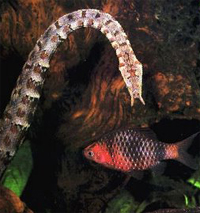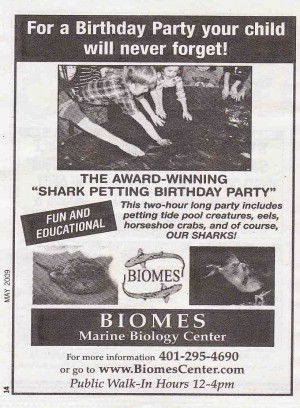Nature
A Little Light Weirdness - 5

Or perhaps this is simply proof that Scottish universities have got the jump on their transatlantic counterparts? In a move nearly, but not quite, totally unlike Jurassic Park, Professor Hans Larsson of McGill University in Montreal has announced that he hopes to de-evolve chickens back into their dinosaur ancestors. Larsson stressed that he is not aiming to recreate whole dinosaurs at this time, but by switching on or off certain genes in chick embryos he hopes to induce atavistic dinosaur anatomy in the full grown animals (AFP).
More in extended >>
Posted By: Dumbfounded - Wed Aug 26, 2009 -
Comments (12)
Category: Animals, Ceremonies, Weddings, Contests, Races and Other Competitions, Cryptozoology, Fictional Monsters, Fairs, Amusement Parks, and Resorts, Geography and Maps, Inebriation and Intoxicants, Nature, Science, Experiments, Surrealism
Sneaky Snakes

Posted By: Nethie - Fri Jul 03, 2009 -
Comments (3)
Category: Animals, Food, Nature, Science
Weird Britannia!
Time to point our telescopes of weirdness at "the old country", methinks.
And it's not just British brains that are shrinking, the UK's sheep are getting smaller as well. Because of a trend towards milder weather believed to be due to climate change, Sheep on the Outer Hebridean island of Soay are getting smaller at the rate of 100g/year, say researchers from Imperial College, London. Though it might seem that warmer winters and a greater abundance of food might make for bigger sheep, Tim Coulson, the professor leading the study, points out that fewer weaker and smaller lambs will die over winter, bringing down the average size (Telegraph).
Now, in some good news, UK campaigners have won a second victory in a three-year battle... to bring back a chocolate bar. The "Wispa Bar", made by European confectioners Cadbury, was introduced in 1995 along with a caramel laced version called the "Wispa Gold", only for both to be discontinued in 2003. This prompted some die-hard fans of the bubbly chocolate bar to start a petition to have it go into production again, resulting in a "limited edition" run of the original Wispa last year. When the 40 million bars produced sold out in just 18 weeks, Cadbury decided to relaunch the brand. Not satisfied with just one bar, campaigners have kept up the pressure, causing Cadbury to start producing Wispa Golds "for a limited period," as before. However to some commentators, this latest move looks more like slick PR than grassroots victory (Sky News).
More in extended >>
Posted By: Dumbfounded - Fri Jul 03, 2009 -
Comments (5)
Category: Animals, Food, Candy, Law, Judges, Nature, Weather, Political Correctness, Religion, Products
Follies of the Mad Men #69
[From The Saturday Evening Post for April 29 1950. Two scans, top and bottom.]
This campaign uses what I like to call "the artificial linkage" method. You take something natural and inevitable and try to tie your product to it. In this case, the entire grand eternal season of Spring means nothing more than digging out your paintbrush and ladders and tackling your peeling house.
You gotta love the name of the paint, though: "Barreled Sunlight."
Posted By: Paul - Fri Jun 12, 2009 -
Comments (0)
Category: Business, Advertising, Products, Nature, 1950s
If You Have A Weak Stomach, Don’t Look
It's amazing what food sellers will put into a can these days. What's even more amazing is that people will buy it. I am reminded of a quotation from a children's movie, where one of the kids asks another, "What wouldn't you eat for a million dollars?" I think just about everything in this article from the Food Network would make that list. (And what's with the Russian Herring? Do they really have teeth like that? Were these grown in a body of water near Chernobyl?)
Posted By: Nethie - Tue Jun 09, 2009 -
Comments (6)
Category: Animals, Food, Horror, Insects and Spiders, Nature, More Things To Worry About
It Just Ain’t Natural!
Here's a quick round-up of a few things that I couldn't quite crow-bar into the "Weird Wildlife" category.If you've any particular aversion to rats, and quite a lot of people have, then Deshnok in India is probably a place best avoided, for there stands the Karni Mata Temple, built a century ago and devoted to the Hindu matriarch Karni Mata. Worshipped as a 14th century incarnation of the goddess Durga, Karni Mata is said to have struck a deal with Yama, the god of death, that all members of her clan would reincarnate as rats so that the clan would remain united. Hence rats in Deshnok are sacred animals, venerated as ancestors, and fed and protected by the locals, so than now thousands of rats scamper over the feet of visitors to the temple (National Geographic).
And it's not only in India that people have built havens for rats, one was once built in British Columbia, though for quite a different reason. Bruce Alexander was studying addiction, and he had a problem. He knew that rats kept in cramped cages or strapped to apparatus that allowed them to dose themselves with drugs, would often do so to the point of self-destruction, but, he thought, could you really blame them? What if the addiction to the drugs was a product of their environment, rather than a reaction to the drug itself? Hence, in the 1970s, Alexander decided to give his rats the best living conditions he could, so he build "Rat Park". It was 95 square-feet in area, and well stocked with food, toys and "private areas" where the rats - who would be of both sexes - could go to mate or give birth. It was then filled with rats who had been forced to consume morphine for 8 weeks prior to the experiment, quite long enough to cause hopeless addiction in standard experiments, who were now offered a choice of pure water, or more morphine. All of them chose water. Nothing Alexander could do would entice them to take the drug, even sweetening it had no effect, only when he added naloxone (a drug that blocks the action of opiates) or diluted the morphine to the point of near impotency, could park rats be tempted to take it (Absolute Astronomy).
Yet another piece of rodent research now, as scientists (sadly not from NIMH) have found that transplanting a human 'language gene' into mice affects the way they communicate with one another. The gene, called foxp2 is one of a small family of genes known to be markedly different in humans compared to apes and other animals, hence may be the genes that are the very core of our humanity, so would putting a humanized gene in a mouse create a talking mouse? Well, no, there's a lot more to our use of language than a single gene, however while the transgenic mice were significantly less curious, they also showed increased growth and plasticity in the speech centres of their brains, and a tendency to use a greater range of frequencies in their calls (NY Times).
More in extended >>
Posted By: Dumbfounded - Sun Jun 07, 2009 -
Comments (1)
Category: Animals, Languages, Nature, Experiments
Shark Petting
If you're ever in New England and wish to dispose of an unwanted rugrat, consider visiting the Biomes marine education facility here in Rhode Island, and participating in one of their "shark petting" programs.Shark petting? Shark feeding!
Posted By: Paul - Sat Jun 06, 2009 -
Comments (0)
Category: Animals, Death, Museums, Nature, Children
The Largest Terrestrial Arthropod

Posted By: Nethie - Tue May 19, 2009 -
Comments (3)
Category: Animals, Nature, Pets, Science, Hermits
Drunk Drivers Can Hit Anything, And Will

Posted By: Nethie - Mon May 18, 2009 -
Comments (3)
Category: History, Nature, 1970s, Africa, Alcohol
Mysterious Worms Invade China

Posted By: Nethie - Sun May 17, 2009 -
Comments (3)
Category: Agriculture, Animals, Nature, Science

| Who We Are |
|---|
| Alex Boese Alex is the creator and curator of the Museum of Hoaxes. He's also the author of various weird, non-fiction, science-themed books such as Elephants on Acid and Psychedelic Apes. Paul Di Filippo Paul has been paid to put weird ideas into fictional form for over thirty years, in his career as a noted science fiction writer. He has recently begun blogging on many curious topics with three fellow writers at The Inferior 4+1. Contact Us |







